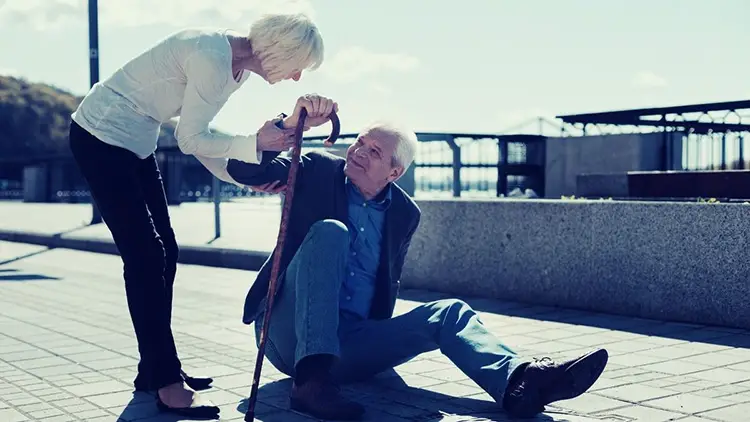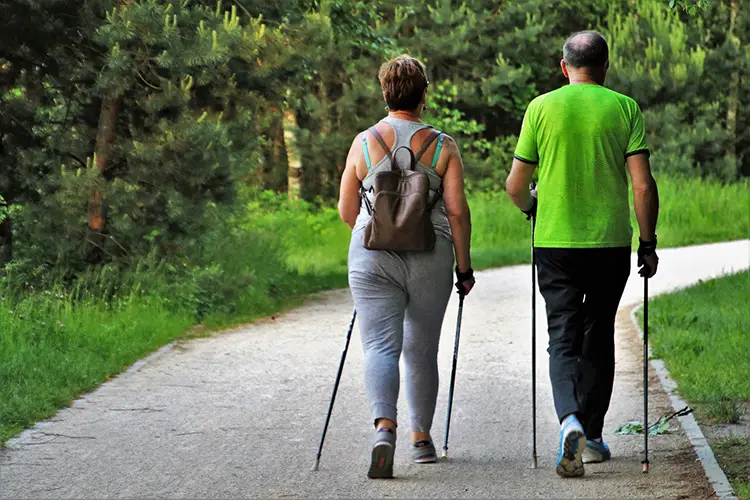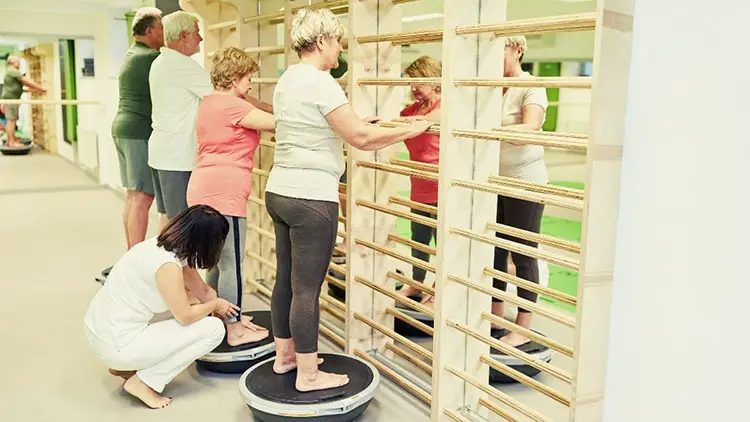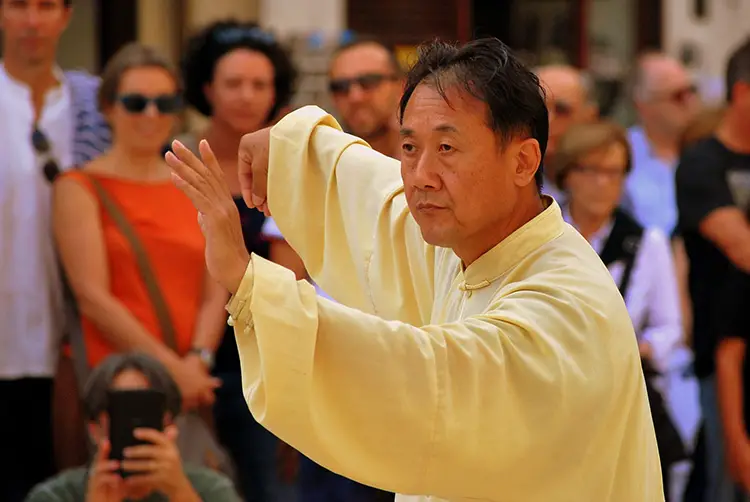Falls can be dangerous, particularly for seniors, and it was with this understanding that the Royal Center for Enhancement of Late-Life Function (at Boston University) teamed up with the New England Research Institute in the 1990s to see if they could do something to address the issue.
The result?
The Matter of Balance program.
Matter of Balance is an exercise program in a series of two-hour classes stretch over eight weeks designed to improve an older adult’s balance.
This is a program that my helped host and teach during my time as Social Services Manager at an Area Agency on Aging, and I observed some of the classes firsthand. Not only did the classes and exercises help seniors maintain or improve their balance, but they also served as social events where older adults could get together, talk, laugh, and have fun. By the conclusion of each series of classes, many of the people who were initially strangers had formed new friendships that carried on after the class.
Why is Balance Training Important?
As we age, we begin to realize just how much of a gift good balance truly is. The adage that you don’t know what you have until you lose it most certainly rings true here. Unfortunately, the ability to maintain one’s balance is yet another aspect of the human body that diminishes as time progresses.
While there are most certainly condition-related factors which can affect balance – diabetes, joint pain, macular degeneration, stroke, etc. – there is some balance loss which is strictly related to age itself.
According to the epidemiological data, if 100 older people fall and break a hip, somewhere between 12-67 of them will die within a year.
A bad fall is often (though it’s important to note not always) the necessary catalyst for a downward spiral of health consequences.
A fall for a senior can lead to serious consequences. And it seems as if falls are relatively common amongst the older population as well. Approximately 20-40% of those aged 65 or older will fall in any given year. While breaking the hip is certainly one of the most feared threats of a fall, there are other potential injuries which can occur as well.
Bruised faces, brain bleeds, torn knee ligaments, and broken wrists are all just some of the possibilities.
But thankfully, there is something one can do to help: balance training.
Just like muscular strength or muscle size, balance can be improved as well. In fact, previous studies have shown that those who regularly engage in balance training decrease their risk of ACL tears in their knees.
Balance training does work when it comes to preventing falls. We’ve even written an article on balance exercises.
The trick is knowing which balance exercises to engage in. There are so many options, and there are so many different people out there as well. While some are physically able to do one-leg stands while holding onto a rail, for others, such an exercise is simply out of the picture.
So, how does one know which balance exercises to perform? How does one find a safe balance training program?
Enter Matter of Balance.
What to Expect in a Class
As mentioned, the Matter of Balance program is a series of two-hour classes over a period of eight weeks. In many aerobics classes it is very easy for the student to become lost in a sea of faces due to a huge attendance. This can make it so that students aren’t able to receive the appropriate instruction which they need to ensure that they are performing all exercises safely and properly.
That’s not a problem within the Matter of Balance classes. Each class is capped at twelve people so there is a proper balance between the instructor and student ratio. This also helps to build a fun community setting within the classes that perhaps would not take place if a larger class was scheduled.
Teachers within the class are those who have been received specialized training through the Master Trainer series at Maine Health (virtual classes available). While the master training comes at a cost, organizations often cover the fee for the trainers. Taking this class to become an instructor could be a great way to volunteer at nursing homes, senior centers, etc. Many will often take the training as part of their job, which is what my staff did at the Area Agency on Aging.
Goals of the class are not only to improve one’s physical ability to balance but also to decrease one’s fear of falling as well. Fear can easily lead to one’s refusing to engage in activities of daily life or exercise that they otherwise would have engaged in. A broken hip isn’t what is immobilizing people in these cases, but instead their own fear.
This in turn can lead to even more negative outcomes. Muscular strength is very important to proper balance and if one is never moving, they are going to lose their muscle size and strength. This in turn leads to an increased risk of falling.
As a result, the fear of falling has turned itself into a self-fulfilling prophecy. Somebody was afraid of a fall and in their quest to avoid such, they’ve only increased their chances of experiencing one.
This video will provide a visual representation of a class with participant experiences:
Matter of Balance seeks to combat this fear via education in addition to exercises.
Students are taught how to properly gauge what needs to be addressed, what is safe behavior, and what is being overly paranoid about a potential consequence. Teachers also show their students how they can make a much safer environment for themselves around their home to decrease their risk of falls without feeling as if they have to be “on guard” every time they stand up on their feet.
Benefits from the Exercises
There are a myriad of benefits which one can experience from participating in a Matter of Balance course, and not all of them are physical either. Let’s look at some of the main positives one will experience from this program…
Improved Balance
The low hanging fruit, Matter of Balance classes help one to improve their balance. As noted above, regular balance training can decrease one’s risk of injury. Perhaps that’s the greatest benefit one can receive because of participating in these classes.
Improved Social Life
As we age, we often end up experiencing ever-decreasing amounts of human contact. The problem with this is that human beings are created as social beings. We do not do well in solitary confinement – even within our own homes. As we’ve pointed out here before at Elder Guru, there are a wide variety of negative health consequences which come about because of virtually non-existent social contact.
This prolonged social isolation results in an increase of morbidity from all causes.
There are two cool things about the Matter of Balance program within this context:
- These classes provide a structured environment for participants to meet and interact with people of the same age and going through the same chapter of life together. This in and of itself is a huge benefit.
- The “social aspect” of Matter of Balance classes is the fact that they are an exercise program. Ask any personal trainer out there and they’ll tell you that few things gets people to open up as well as exercise does.
There’s just something about it which causes people to tell you what they really think about something, about what is going on in their life, and more. It’s a time where people unwind and uncoil all that’s been wrapping itself around their head for some time now.
Removing Fear
One of the interesting findings from the decades of study which have been performed on Matter of Balance classes is that they’ve been found to also decrease one’s fear of falling. Where fear plays a much larger role in falling than many people would choose to admit. If fear can increase one’s risk of a fall, then something needs to be done to address even this.
Where to Find Matter of Balance Classes
Area Agencies on Aging
The easiest way to find a Matter of Balance class near you is going to be checking with your Area Agency on Aging (find it here). Maine, my home, hosts many classes while other states host few or none.
The program is present throughout the country, however, and simply conducting an online search for “[your state] Matter of Balance class” could yield the results you’re looking for.
Hospitals
Many hospitals have their own clinician-led fitness programs. These are often small gyms which are staffed by exercise physiologists trained in personal training those with special medical conditions. Balance is one of those conditions that exercise physiologists are trained in providing care for.
Oftentimes these hospital-run fitness facilities will run programs of a very similar nature to the Matter of Balance class. Asking those who work at your local hospital could be a very good place to begin your search.
Local Gyms
There are often numerous gyms throughout any locality, and they are all vying for the same customer base. One of the ways they do this is by offering specialty classes which they think will help them to improve their bottom line. If a gym discovers that it can bring in an additional $10,000/year by adding a Pilates class to the schedule’s rotation, it’s going to do it.
If the gym discovers it can bring in funds from a Matter of Balance class, it will do the same. Even if the gym of your choice doesn’t offer a Matter of Balance class, the fitness community is incredibly tight knit. Not only do personal trainers and aerobics instructors often train at multiple locations, but they know about all the classes that are offered in their area as well.
These people can be a wonderful source of information as to what is currently available within a community.
Other Ways to Improve Balance
Should there not be a Matter of Balance class that is currently offered in your area, do not fret. It is by no means the sole way by which one can improve their balance. In fact, it’s far from it! There are other activities which can be engaged in which will help one to improve their balance over time.
Lifting Weights
There is some debate as to whether one’s bones break after the fall or cause the fall when one has osteoporosis, but no one will debate those weak bones aren’t good for balance (weak bones go hand in hand with weak muscles).
The cool thing here is that not only does lifting weights help to stop the rate of bone loss (and this author has personally witnessed bone loss regress via regular weight lifting programs), but that it also improves balance as well!
Riding an Elliptical
While just about any form of cardio will help to build strength and assist in balance training, some have noted that the elliptical can serve as a great means of building one’s balance. This is a difficult exercise, but if one can perform it safely, it can be an effective workout. As always though, check with your doctor before beginning any exercise program.
Stationary Cycling
The rectus femoris is the large muscle that runs atop one’s thigh and it’s a very important muscle for balance. Riding a bike is a great way to work this muscle. Studies have shown that when stationary cycling is combined with balance training that the improvement in balance is much more than would have taken place via balance training alone.
So, don’t just take Matter of Balance classes! Consider stationary cycling as well!
Tai Chi
There are a few benefits to regularly engaging in tai chi, such as improved oxygen flow, reduced stress, and alleviated arthritis pain, but it’s also been shown to be a very potent means of “treating” poor balance. Prior studies have shown that regular tai chi can decrease one’s risk of falls by 45%.
Physical Therapy
Should your balance be poor enough to warrant such, your doctor can prescribe you a course of treatment with your local physical therapist. If your insurance pays for this, this can serve as a great means of one-on-one instruction as to what you need to do to become more stable on your feet.
Summary
Maintaining one’s balance as time progresses is a never-ending battle, but it’s one that must be waged, nonetheless. Like many things in life, balance has a particular ‘use it or lose it’ quality to it, and if it is not trained, it is lost.
That’s where the Matter of Balance class can step into the gap and help to give one not only the one-on-one (well, really one-on-twelve, but who’s counting?) training that one needs to figure out what it takes to maintain one’s ability to balance as well as possible.
Have you ever taken a Matter of Balance course before? What were your thoughts? Let us know in the comments below!




